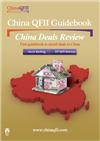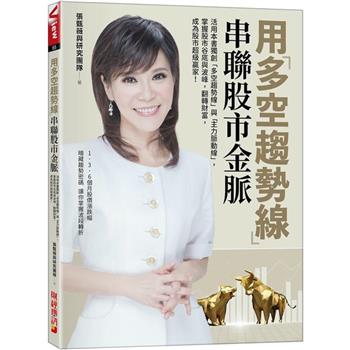自2003年以來,越來越多的合格境外機構投資者(QFII)開始進入中國市場。本書介紹了這些機構的背景資訊,以及他們如何為國內市場的發展做出貢獻,是投資者瞭解國外同行的重要參考資料。另外,作為這一領域的首部出版物,本書將為個人投資者和機構投資者(如QFII、私募基金、對沖基金和多頭基金)提供重要資訊,以助瞭解QFII從而制定自己的投資策略。同時,本書也將展示我們在下列專題的研究成果:
合格境外機構投資者(QFII)最偏愛投資哪些行業?
不同類型的合格境外機構投資者(QFII)又偏愛投資哪些行業?
合格境外機構投資者(QFII)更偏愛各個行業內的哪些公司?
書中收錄的對237家QFII公司的詳盡描述將幫助您逐一瞭解他們的背景和投資偏愛。
| FindBook |
|
有 1 項符合
郭子中的圖書 |
 |
$ 1056 | China QFII GuideBook中國合格境外機構投資指南(精裝)
作者:郭子中、關啟正 出版社:藍天圖書 出版日期:2013-10-25 語言:繁體書  共 2 筆 → 查價格、看圖書介紹 共 2 筆 → 查價格、看圖書介紹
|
|
|
內容簡介
作者介紹
作者簡介
郭子中
郭先生是前中國平安集團QFII部門主管,同來自美國、歐洲、中東、非洲以及亞太地區的QFII公司長期接觸,擁有同合格境外機構投資者(QFII)、合格境內機構投資者(QDII)、合格人民幣境外機構投資者(RQFII)、合格境外有限合夥人(QFLP)以及中國A股公司、中小板企業、私人企業和私募基金的密切聯繫。
關啟正
關先生曾就雇於麥肯錫、瑞士銀行和摩根大通,並在摩根大通投資銀行部負責亞太區金融機構業務。
他畢業於香港科技大學,獲得一等榮譽學士學位,並擁有香港大學金融學碩士學位。
他亦持有金融風險管理師(FRM)和特許另類投資分析師(CAIA)證書。
目錄
List of Qualified Foreign Institutional Investor (QFII) 合格境外機構投資者
Foreword
About ChinaQFII Company Limited 中國橋金融網有限公司
Acknowledgement
Timeline of China Financial Market
Introduction of China Stock Market
China Stock Market Analysis
Overview of QFII Scheme
QFII and Private Equity / Deals in China
Ranking: Top Favorite Sector by QFII
Ranking: Top Favorite A shares by QFII
QFII Directory and Deals Review 1 - 237
Appendix A – List of Qualified Domestic Institutional Investor (QDII) 合格境內機構投資者
Appendix B – List of RMB Qualified Foreign Institutional Investor (RQFII) 人民幣合格境外投資者
Appendix C – China Companies / Organizations Visit
Appendix D – China Ping An Group Review
序
QFII, which stands for Qualified Foreign Institutional Investors (合格境外机构投资者), has now been in existence for over 10 years. In 2002, the “Provisional Measures on Administration of Domestic Securities Investments of Qualified Foreign Institutional Investors” was promulgated by China Securities Regulatory Commission (“CSRC”) and People’s Bank of China, which marked the beginning of China’s QFII program.
Since the inception of QFII, 237 financial institutions have received QFII license and US$46.4bn was given out by State Administration of Foreign Exchange (“SAFE”) as of August 2013. The approved quota contributes to around 1.5% of China stock market capitalization.
As the foreign pioneers of China’s securities market and under the guidelines set out by CSRC, QFIIs have been investing mostly in stocks and bonds. However, some QFIIs have expanded their investment portfolio into different asset classes such as private equity and venture capital, while some acquire and form joint venture with Chinese companies. An example of this kind of transaction is the investment of Goldman Sachs and Morgan Stanley, two QFII license holders, in Ping An Insurance (Group) of China in June 1994.
Ping An Insurance (Group) Company of China, Ltd ("Ping An") [2318.HK / 601318.CN] was established in 1988 in Shenzhen. The firm comprises three main business areas – Insurance, Investment and Banking.
• Insurance – Life, Property & Casualty, Annuity, Health
• Investment – Trust, Securities, Asset Management
• Banking – Ping An Bank (Acquired from Shenzhen Development Bank)
As the former Head of QFII Division in Ping An, I had the great pleasure to be part of this financial giant and experienced the ebbs and flows of the economic cycle with the Group. Ping An has also been prudently investing overseas from its first overseas investment in Fortis Investment in 2008. Along with its overseas investment and my role to develop QFII business, I had the opportunity to conduct roadshow in major cities across Europe, the U.S. and key cities in Asia, and to pitch Ping An’s strong capability in serving QFIIs.
Based on my experience and discussion with over 200 QFII key executives, they are not only looking for good investment opportunities within traditional asset classes in China, but also actively searching for alternative investments, for instance, private equity, venture capital, merger and acquisition, and joint venture. As far as private equity is concerned, roughly 74% of QFIIs have their in-house private equity team or become a limited partner of private equity funds. For example, OrbiMed Advisors LLC, which received a QFII license in October 2012, had invested in Beijing East Whale Imaging Technology in China in 2012. Meanwhile, some QFIIs, due to foreign restriction in establishing wholly-owned subsidiaries in China, have set up joint ventures with Chinese companies in order to expand their footprints in China. One example is the partnership between UBS and State Development Investment Corporation to establish UBS SDIC Fund Management in 2005.
Given the increasing demand of foreign institutions looking to invest in Chinese private market and a growing number of Chinese companies seeking foreign capital and partnership, I have founded “ChinaQFII Company Limited” with my partners to build up a truly unique and first platform to bridge the two sides – China and the World – hoping to facilitate private market investment and identify attractive investment opportunities.
In order to let interested readers understand the history of QFII, and what kind of investment QFII license holders have made in China, our team has prepared the first publication “China Deals Review” to uncover some of the significant transactions for each QFII licensee. Our team wholeheartedly wishes you enjoy and benefit from reading this book as much as we enjoyed writing it.
William Kwok
Chief Executive Officer
ChinaQFII Company Limited
|









